
Oliver Esman is hiring for two Vice President roles in Fulfillment, one in Tennesse and one in Pennsylvania. For more information or to apply, contact Oliver at [email protected].

Oliver Esman is hiring for two Vice President roles in Fulfillment, one in Tennesse and one in Pennsylvania. For more information or to apply, contact Oliver at [email protected].
by Jenny Crutchlow

Understanding diverse leadership styles and their impact, and knowing which style is needed for your organization’s current situation, is crucial for hiring teams as they assess potential candidates. Here’s a closer look at various leadership styles and how they can influence your team and company culture:
Transformational Leadership: These leaders inspire and motivate their teams to exceed expectations by fostering an environment of innovation and change. They are visionaries who can drive significant organizational growth.
Transactional Leadership: Focused on structure and results, transactional leaders excel in setting clear goals and using rewards and penalties to achieve them. This style is effective in achieving short-term goals and maintaining routine operations.
Servant Leadership: Prioritizing the needs of their team members, servant leaders build strong, supportive relationships. This approach enhances team morale and loyalty, leading to higher employee satisfaction and retention.
Democratic Leadership: By encouraging team participation in decision-making, democratic leaders foster a collaborative and inclusive work environment. This style can lead to more creative solutions and a strong sense of ownership among team members.
Autocratic Leadership: Autocratic leaders make decisions independently, which can be effective in crisis situations or when quick, decisive action is needed. However, this style may limit team input and creativity.
Laissez-Faire Leadership: Offering minimal supervision, laissez-faire leaders empower their teams to take the lead. This style works well with highly skilled and self-motivated teams but may lead to a lack of direction if not managed properly.
Each leadership style has its strengths and potential drawbacks, depending on the team and the current needs of the organization. The key is to identify the style that aligns with your organizational goals and culture. By understanding these dynamics, hiring teams can make more informed decisions and place leaders who will drive success.
Ready to find the right leader for your team? Let’s connect and explore how we can help you achieve your goals.
At Strawn Arnold, we are proud to support World Immunization Week 2025, celebrated from April 24-30. This year’s theme, “Immunization for All is Humanly Possible,” highlights the incredible achievements of vaccines in saving lives and protecting communities worldwide.
Why Immunization Matters:
We at Strawn Arnold specialize in connecting top talent with leading organizations in the life sciences sector. We believe that strong leadership in healthcare is essential to advancing global health initiatives like immunization. By placing the right leaders in the right roles, we help drive innovation and ensure the success of vital health programs.
Let’s work together to promote the life-saving power of vaccines. Support World Immunization Week by raising awareness, advocating for strong immunization programs, and ensuring that vaccines reach every corner of the globe.
Learn more about World Immunization Week 2025: https://lnkd.in/gKxXA87f
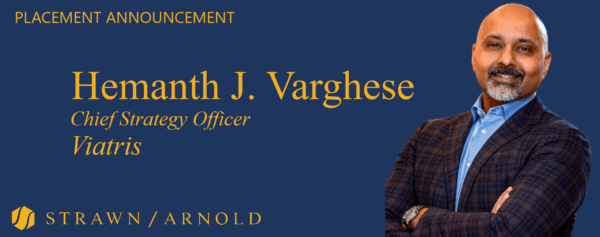
We are excited to announce that Hemanth J. Varghese has been appointed as Chief Strategy Officer at Viatris. Hemanth brings over 20 years of strategy, operations and corporate development experience in the healthcare space in multi-national companies. We are confident that Hemanth will play a pivotal role in shaping the future of Viatris, and we look forward to seeing the successes that will follow!
Read more about Hemanth’s appointment here: https://lnkd.in/g6hhJgBA

We are thrilled to announce that Strawn Arnold has once again been recognized as one of the Top 40 Life Sciences Recruiting Firms by Hunt Scanlon, highlighting our steadfast dedication to excellence in our industry. Our team’s commitment to connecting leading organizations with top talent continues to drive innovation for our clients.
A huge thank you to our incredible team, clients, and partners for their support and trust. Together, we are making a significant impact on the future of life sciences and the patients we all serve.
Let’s continue to push boundaries and achieve great things!
https://lnkd.in/gghGr2Dt
by Oliver Esman
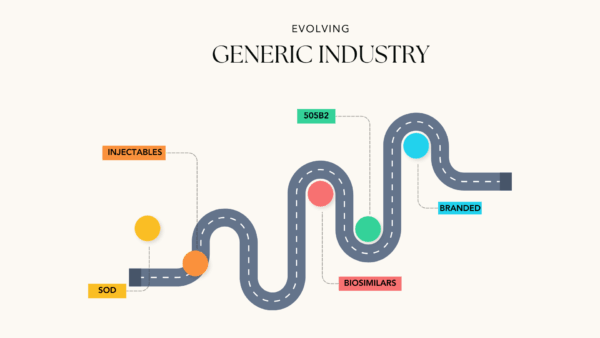
Over the past 20 years there has been a remarkable transformation of the generic industry space as the industry has moved away from dependence on commodity solid oral dose (SOD) generics into higher margin products. My search practice has followed the industry. When I began 18 years ago, the bulk of the industry was still focused on SOD products. As the patents fell on attractive and more complex injectables and solid orals, the industry began a shift to more complex products. Many companies offshored commodity products to less expensive manufacturing geographies, specifically India leading in part to the rapid growth of the Indian pharmaceutical manufacturing sector.
More recently many generics companies have begun to move into 505b2 type products, biosimilars, and branded products of all stripes, pursuing higher margins and longer patent protection. As that process continues, generic companies are more properly becoming specialty pharmaceutical companies with broader and more profitable product lines that often include complex generics, biosimilars, and branded products.
This process has also required companies to look at a broader range of talent throughout their companies to meet the demands of developing and marketing this broad range of products. As the industry has changed our search practice has followed. We now regularly recruit for branded, biosimilars, and complex 505b2 experience in a range of critical functions from commercial activities to manufacturing, quality technical, regulatory affairs, and R&D.
There continues to be strong demand for talent throughout our evolving industry. We expect that to continue as we weather the current choppy business climate. Supply chain instability, payer pressure, regulatory headwinds, pricing reforms, and competition, among other market forces, will only increase the demand for top executives who can lead in this environment. It has been an exciting journey to both watch the development of the industry and be an active participant.
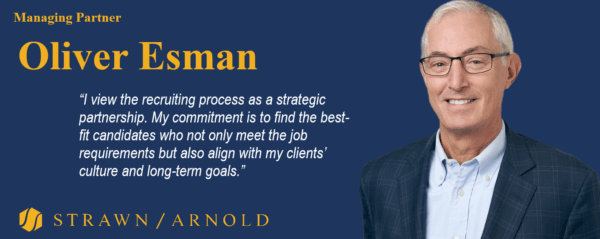
Meet Oliver Esman, long-time Partner and Leader at Strawn Arnold. Oliver’s transition from a seasoned Human Resources executive to a successful professional in retained executive search is a narrative of dedication and expertise. With a robust background in life sciences, Oliver’s corporate experience laid the foundation for his successful tenure at Strawn Arnold and his continued contributions to the field.
His journey in life sciences began with Schein Pharmaceutical, an early leader in the generics market and continued as VP of Human Resources for Sandoz North America. Oliver joined the generics industry in the early days of its development and has had the good fortune to grow with it as the industry has evolved and as companies diversified into branded products, 505b2s and biosimilars. He has developed long-standing relationships with hundreds of key builders and contributors in the generics space.
Oliver believes that understanding the pharmaceutical industry and his clients’ specific needs is paramount. “I view the recruiting process as a strategic partnership. My commitment is to find the best-fit candidates who not only meet the job requirements but also align with my clients’ culture and long-term goals.” Oliver’s career has been a story of making a meaningful impact on an industry he truly cares about.
We applaud Oliver’s unyielding dedication to our clients, the pharmaceutical industry as a whole, and the patients they serve.
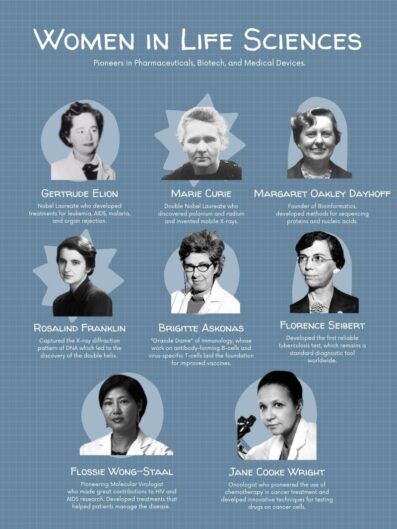
As we celebrate Women’s History Month, we take this opportunity to honor the incredible women who have made significant contributions to the pharma, biotech, and medical devices industries. Their dedication, innovation, and leadership have not only advanced these fields but have also paved the way for future generations of women leaders.
At Strawn Arnold, we are proud to support and champion the achievements of women who break barriers and drive progress in life sciences. Throughout the history of our industry, women have been and continue to be at the forefront of transforming healthcare and improving lives. This month, and every month, we celebrate the women who inspire us with their resilience, passion, and unwavering commitment to excellence.
Join us in celebrating these remarkable women in pharmaceuticals, biotechnology, and medical devices. Let’s continue to support and empower each other as we work towards a brighter, healthier future for all.
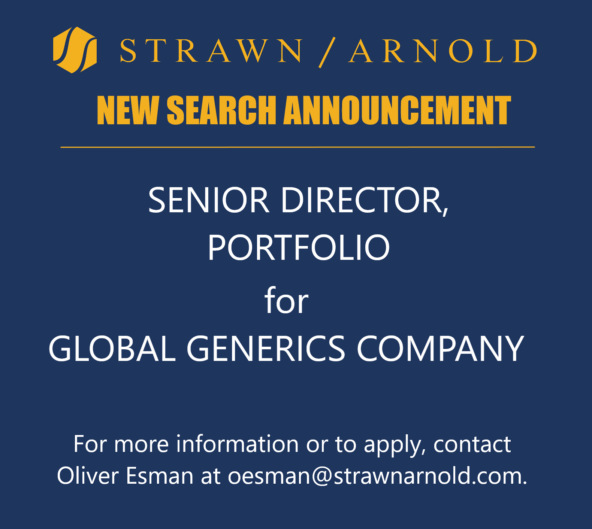
We’re hiring a Senior Director, Portfolio for a Global Generics Company. For more information or to apply, contact Oliver Esman at [email protected].
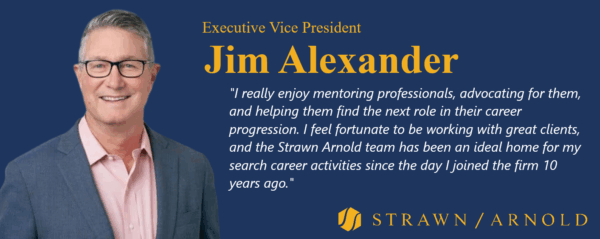
We are excited to feature Executive Vice President, Jim Alexander, a 10-year veteran of retained search with Strawn Arnold with over 30 years in leadership roles in the pharmaceutical industry, academia, and professional organizations.
Jim is proud of his Midwest heritage and is an alumnus of the University of Nebraska where he earned his Doctorate degree in pharmacy. He began his career journey with Warner-Lambert/Parke-Davis moving through leadership roles on the commercial side, eventually rising to Vice President of Corporate Development and Licensing.
Jim moved to academia to become the first Director of the Rutgers Institute for Pharmaceutical Industry Fellowships. During this professionally rewarding 10-year period of his industry-focused career, he was responsible for the administration of the premier Post-Doctoral Fellowship Program for pharmacists and trained, mentored, and helped place hundreds of PharmDs who are now working throughout the entire pharmaceutical/biopharma industry. Jim is also the founder of the Industry Pharmacists Organization, the first professional organization designed exclusively for industry-based pharmacists, which has successfully evolved into a well-known PharmD talent pipeline for the pharmaceutical industry.
Jim entered the field of Executive Search to build on his passion for helping professionals advance their careers. “I really enjoy mentoring professionals, advocating for them, and helping them find the next role in their career progression. I feel fortunate to be working with great clients and the Strawn Arnold team has been an ideal home for my search career activities since the day I joined the firm 10 years ago.”
Jim’s passion for mentoring and his extensive contributions to the pharmaceutical industry have greatly enriched our team and clients. Join us in honoring his outstanding achievements and dedication at Strawn Arnold!